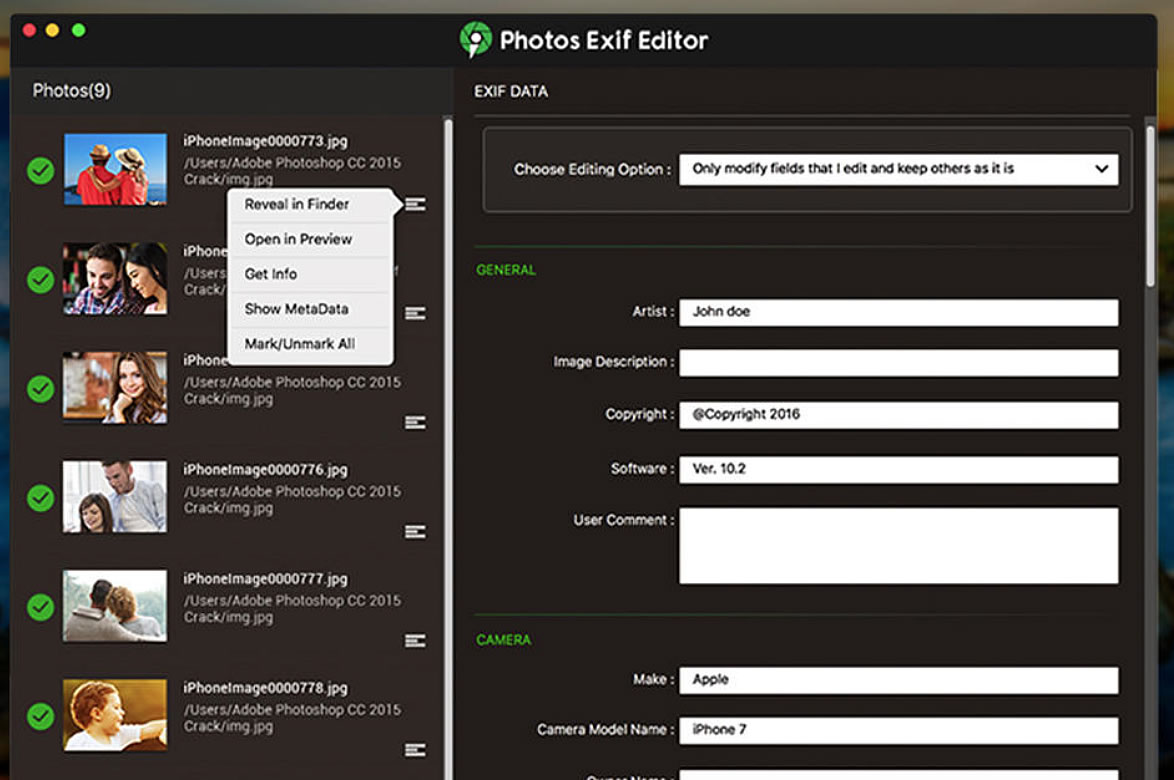


You can subsequently strip the autorotate tag (contextual menu under JPEG) and rotate by hand yourself, or in the same jpeg contextual menu, there is even a Rotate depending on EXIF command.* You can either turn on or off Auto Rotate (in the Preferences panel at the top under Digital Camera.
#Exif editor osx mac os
GraphicConverter, the all round greatest graphics application ever created for Classic and Mac OS X, outside of Photoshop (and a bargain at 1/20th the price of Photoshop) also does lossless rotate. Highly recommended.Īny version of iView MediaPro has a perfectly adequate lossless jpeg rotate, although in versions prior to 2 jpeg rotate was very slow (think 1.5.7 which some people are still using).
#Exif editor osx free
If you are still using Panther like me, there is a wonderful free contextual menu plugin which does a great batch jpeg rotate (although it is quite slow on my 1.5 GHz Powerbook) called PhotoTools which does jpeg rotate and much more. The difference wasn’t immediately visible but in subsequent photo editing would show up quickly. The size of my original photos dropped from 2.6 MB each to 800 kb.

Version 2.1 jpeg rotate in Apple Preview (OS 10.3.9) is extremely quick but is not lossless. In the Canon S45, you’ll find Auto Rotate towards the bottom of the settings menu (under the golden hammer and wrench).ĭo not use Apple Preview for jpeg rotate function. In the Canon 20D it’s simple enough thank heavens: in the yellow settings menu – Autorotate – On/Off. The first is to turn off the auto-orientation tagging in your camera, and rotate your jpegs by hand as everybody used to do in the good old days. There are two solutions to the Auto Rotate conundrum. That kind of slowdown is unacceptable, as I’ve recently found out working through 350 high quality jpegs from the Budapest Parade (normally I shoot RAW so I haven’t had a lot to do with the orientation tag, especially as my previous principal cameras the Pentax *ist DS and the Panasonic Lumix LZ10 don’t support the tag).

With large files (Canon 20D jpegs anybody), Preview and iView MediaPro slow down significantly (I’ve read 7 seconds to 2 seconds) when trying to show Portrait oriented jpeg originals that are being reoriented on the fly. There are some other hidden gotchas with EXIF based auto rotate. When you save a copy out of Photoshop it will stay that way.īut in the end, the automatic rotation won’t save you when it’s game time and its time to post your images…Īs soon as you you try to upload your automatically oriented pictures, a rude surprise awaits. The image will show up correctly orientated. When it comes time to opening your pictures in Photoshop or Elements, you’re also covered. iPhoto does as well (from version 5 and up but somebody else will have to test this as I won’t run iPhoto on my computer – a friend lost half of her European pictures to its vagaries). IView MediaPro recognises the orientation tag as well (version 3.1.1 and I believe has done so from version 2.6 and up). Apparently in Mac OS 10.4, Preview recognises the tag and performs the rotation automatically.
#Exif editor osx mac os x
In Mac OS X 10.3.9, Apple’s built-in image and PDF browser preview ignores this tag (Preview version 2.1).
#Exif editor osx software
It’s when the software acts on EXIF orientation things get complicated. At a basic level, some software ignores the tag altogether. Image software packages handle EXIF orientation in various and complex ways. In fact, EXIF based photo orientation is a mixed lot for the end user. In principle, automated photo orientation based on EXIF tags should be a very good thing, saving the user time and trouble. Many image software applications handle these rotations automatically in their most recent versions. Technically this is done with an orientation tag embedded into the picture. How does it work? The camera leaves a comment on the EXIF file for image software to rotate the camera the same way it was held at the time the picture was taken. This includes most modern Canon and Nikon cameras, as well as those of other manufacturers but not including, notably for me, Pentax DSLR up to the *ist DS. Many modern cameras digital include a sensor which tells the camera if it is in Portrait or Landscape mode. Photo orientation is the way your photos look coming out of the camera – there are two alternatives Landscape (horizontal) and Portrait (vertical).


 0 kommentar(er)
0 kommentar(er)
